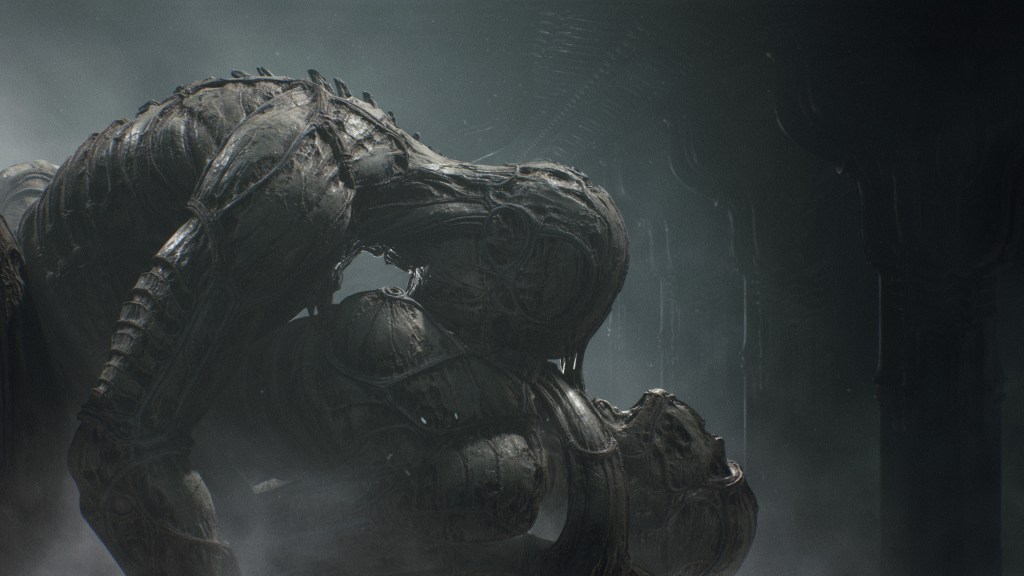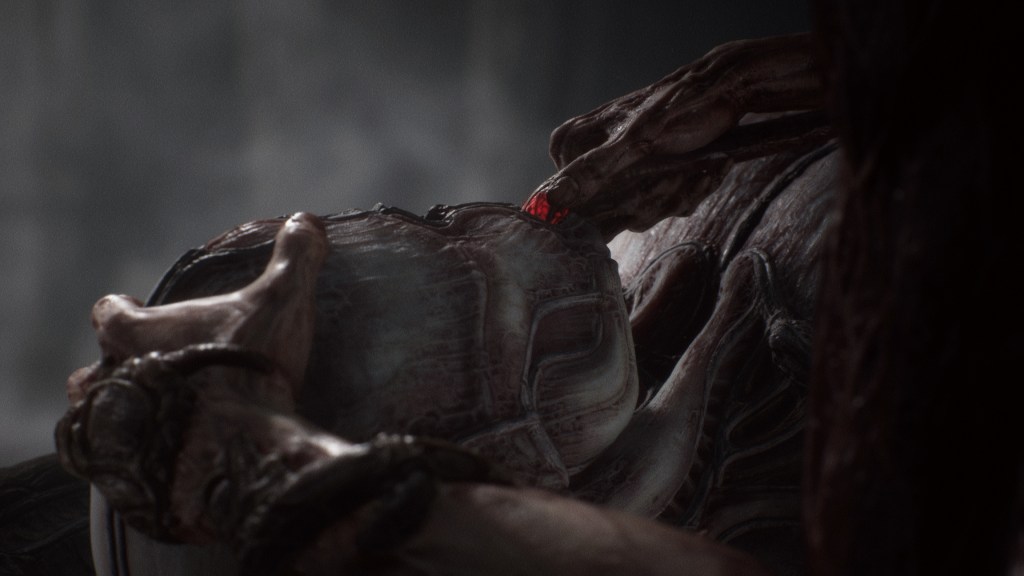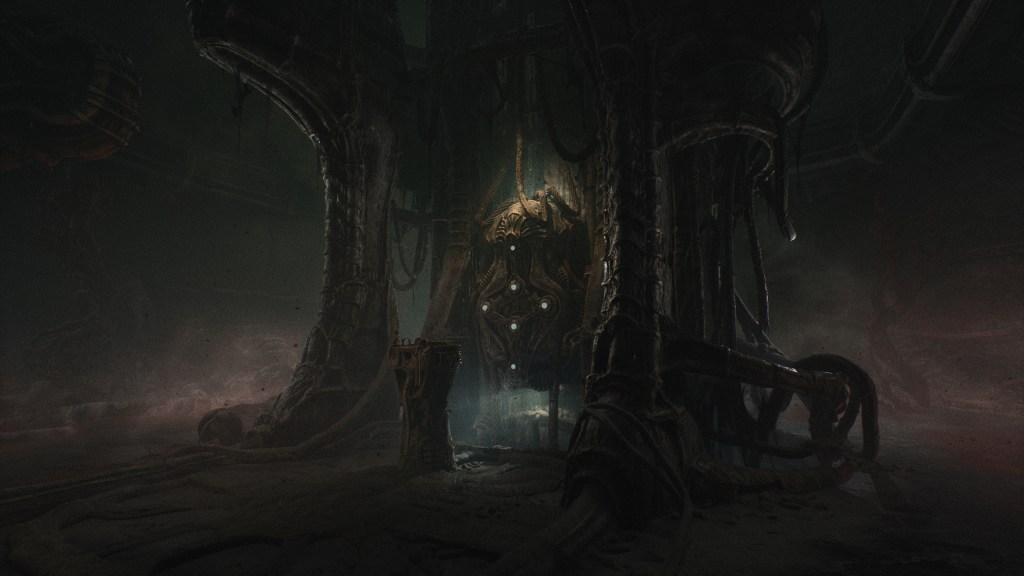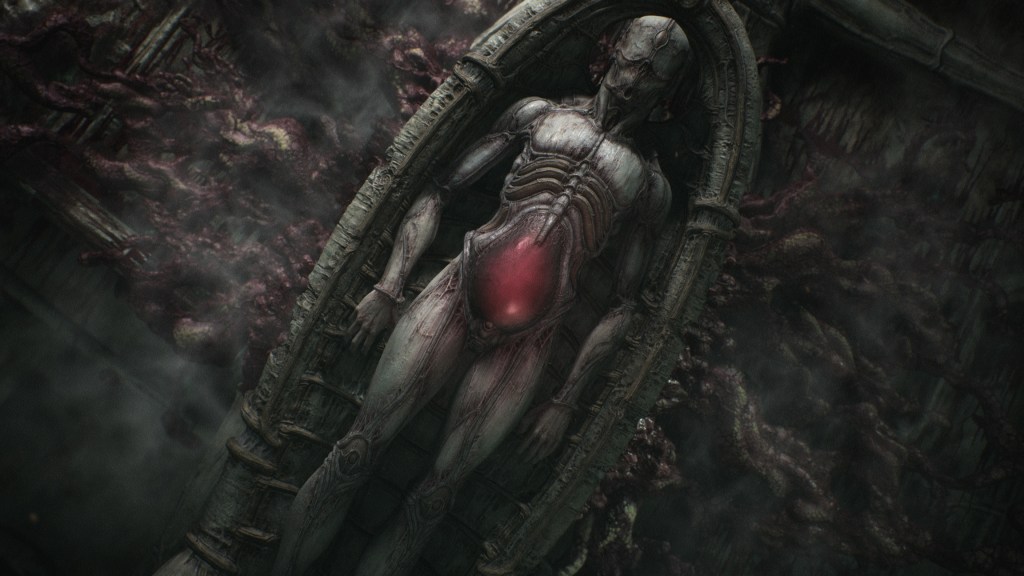How Scorn Turned the Art of H.R. Giger into a Nightmarish Horror Game World
Xbox Series X console-exclusive horror game Scorn turns the work of artists H.R. Giger and Zdzisław Beksiński into a new interactive nightmare.
Ebb Software’s long-awaited horror shooter Scorn is designed to make you squirm in your seat from the second you lay eyes on it. Set in a gruesome world of bone, flesh, and sharp steel, the game is meant to be repulsive, but it’s also absolutely entrancing. The imagery is visceral and gory — from tendrils of meat hanging down from big, grotesque statues to the bloody creatures crawling all over the walls to the webby, diseased-looking membrane covering the skinless protagonist’s head — but you also can’t look away.
According to game director Ljubomir Peklar, the game’s visual style is meant to challenge what we generally consider to be beautiful.
“Human beings are conditioned to like the external beauty of their bodies and see the internal organs, bones, and tissue as something repulsive. It’s a reflex,” Peklar said of the game’s art direction in an interview with Rock.Paper.Shotgun in 2016. “Our existence as a living organism is at the core of the game and human anatomy is the primary subject. Therefore we referenced many different parts of it as a starting point, then we morph, combine, and exaggerate them, change the shapes until we get something visually appealing. It’s not always about functionality but interesting forms that make sense for what we are trying to express.”
It’s clear the team at Ebb is trying to express a deep fascination with the organic while also making sometimes literal connections between living things and machines. Take the game’s main weapons, the pistol and shotgun, which are living organisms with mouths where you’re meant to insert the bullets. There are ribbed cables that run through structures resembling organs, while leaking phallic-shaped mouths protrude from the metal walls.
Scorn‘s challenging and disorienting art style could make it a defining work of horror gaming, but even if it’s not, it’ll certainly be one of the most visually interesting games on the Xbox Series X when it launches later this year. You can see what I mean in this trailer of the game running on the next-gen console:
It’s no secret that this Gothic hell is heavily inspired by the work of two of the greatest surrealists to ever touch a canvas, the Swiss artist H.R. Giger, who you may know best for his designs for the sci-fi horror movie Alien, and the Polish painter Zdzisław Beksiński, whose grim creations are particularly responsible for all of the gore in the game’s environments. This isn’t the first time their work has shown up in some form in a video game, but Scorn could very well be the most faithful of the bunch.
Giger most famously collaborated with developer Cyberdreams in the early ’90s, providing access to his artwork for the psychological horror point-and-click adventure game Dark Seed and its sequel Dark Seed II. But the use of Giger’s work in that game can only be described as “quaint” when compared to what Scorn is doing. After all, the technological limitations of the time prevented Cyberdreams from truly building something out of Giger’s art, forcing the team to instead use his airbrushed paintings as backgrounds in the game to set the mood of the somewhat peculiar plot.
“Actually I think no one really did it the right way,” Peklar says of past adaptations of Giger’s work in an email to Den of Geek. “I don’t remember too much of Dark Seed, I played it a very long time ago. I do know that the artwork was just H.R Giger’s already established work collaged into the background. It was not designed from the ground up to be a setting in a game.”
Peklar asserts that no one has done what Scorn has set out to do. Peklar is not only interested in capturing the look and feel of Giger’s twisted work but also the meaning behind the pieces.

“Giger’s visual influence can be seen in many forms, from movies to games, but only superficially, to represent aliens, monsters maybe some strange planet, etc. Nobody truly dealt and realized Giger’s work thematically,” Peklar says. “His work is the most fascinating part but always sidelined, never the focus.”
Director Ridley Scott might take issue with Peklar’s comments, especially since so much of Alien‘s world is based on Giger’s unique vision, but even those movies don’t quite delve into the full breadth of the artist’s work, which often portrayed human beings in a physical, often erotic, relationship with machines, a style the artist called the “biomechanical.”
Indeed, you can see Giger’s “biomechanical” style in the way Scorn‘s protagonist “plugs into” an exoskeleton made of bone in the XSX trailer or how he sticks his arm inside of a terminal, veins like spaghetti running through the “computer’s” circuits to activate a machine in gameplay footage from 2017.
“It’s not about alien worlds, no matter how many people think that’s what his art is about,” Peklar explains. “There is a much more important subtext to it. It’s about the interweaving of human beings and technology. The organism as a structure that defined our existence up to this point, fused with our own mechanical creations in a ridiculous dance of libido and death. Freudian concepts that both move and terrify us.”

If Giger’s work emphasized the symbiosis between the living and the mechanical, the less well-known Beksiński was more interested in man’s connection to death. Many of his pieces, which often depicted dystopian settings riddled with skeletons and corpses presided over by red, bleeding skies, seem to have a singular focus: the apocalypse and what comes after.
Beksiński loved to paint decaying bodies and skeletal figures stripped of the features that once made them human, like faces and skin. One particularly haunting painting depicts a man’s eyeballs spilling — or perhaps growing out like roots — from their sockets in messy ropes of red. Beksiński’s work is likely the most responsible for Scorn‘s faceless protagonist, whose body is mostly made up of skinless muscle tissue and nerves, with the bones of a naked ribcage protruding from his chest.
Peklar tapped concept designer Filip Acovic to create the look of Scorn, from the levels to the protagonist to the weapons, but the goal wasn’t to just produce a “mere homage to Giger” or Beksiński, as the director told Shacknews in May.
“[Giger and Beksinski] are certainly the two main visual influences but their work was not chosen because it looks cool but because different aspects of their work relate to various themes and ideas in Scorn. We also tried to create our own style,” Peklar told Rock.Paper.Shotgun.
Peklar tells Den of Geek that he believes “the art style should always be in service of the themes and the ideas of the game.” But what is Scorn actually about? Peklar is more secretive about the game’s plot, which will unfold through environmental storytelling as opposed to cinematics. In fact, the director wishes he could have kept the game’s whole existence a secret for much longer than he did.

Since Scorn was announced in 2014 for PC, it has gone through two Kickstarter crowd funding campaigns and was initially set to be released as a two-part experience before announcing a full release on Xbox Series X and Xbox Game Pass in May.
“The reason you heard about the game in 2014, 2016, and 2017 was because we were running out of resources so we had to show it and gather interest so we could convince people to invest in the studio. I said it quite a few times, if I had the all the resources needed to develop the game without public knowing about it I most certainly would. You would be probably hearing about the game for the first time now and thinking it’s a new game.”
Yet, six years of cryptic trailers haven’t betrayed the secrets of a game that was “designed around the idea of being thrown into the world.” Like the Giger and Beksiński pieces that inspired him, Scorn‘s macabre dreamscapes may defy explanation, according to Peklar.
“Like the best of nightmares, that surreal imagery will start playing with your psyche the more you play the game,” Peklar told Shacknews. “When you wake up from a nightmare it’s really hard to define what you dreamt, only snippets remain, and the feeling of anxiety. That is something we are trying to recreate.”
In the Shacknews interview, Peklar compared the feeling of traversing through Scorn‘s work to the hectic opening Dario Argento’s horror masterpiece Suspiria: “It’s a montage of sights and sounds that creates the uneasy feeling. Nothing is set up story-wise and nothing truly graphic is happening. It just is.”
While Peklar looked to horror classics like Resident Evil and Silent Hill for the environmental storytelling that ties Scorn together, Peklar told PC Gamer in 2017 that he wasn’t interested in a scripted story for the game:
“We are not trying to push traditional plot-driven narrative. That is where these games fail for me. Writing an interesting story requires a good writer, and game developers or writers that specialize in games writing are not very good. If they were, they would write a book or a screenplay. That’s the right medium for the job. Games for me are about interactivity and telling you a story through it.”
Ultimately, what Scorn‘s story is about may not be as important as what players take away from it. Peklar says that he’s happy to let “players to give their interpretation of the game.”
Giger and Beksiński aren’t the only influences on Scorn, according to the director, who says filmmakers like Alejandro Jodorowsky, David Cronenberg, David Lynch, Dario Argento, and John Carpenter are also major inspirations.

“Cronenberg’s main concept that puts our organism at the center of human existence and Giger’s bio structures intersect in many ways,” Peklar says. “Lynch’s surrealness captures the strangeness of the world we inhabit and an oneiric sense of our own being.”
Peklar also cites surrealist writers Franz Kafka and Jorge Luis Borges, whom he says “mostly dealt with the absurdity and weirdness of human existence in this mysterious universe.” Then there’s horror writer Thomas Ligotti, “who deals with all the horrors that come with it,” and the dystopian J.G. Ballard, who “bounds it all together in technological nightmares of sex, violence, and decay.”
What we’ve seen and heard of Scorn so far points to this year’s most twisted game, perhaps even the most uncomfortable visual experience ever released on a console. As I rewatched the footage of the game in preparation for this article, I wondered whether Peklar was worried that gamers would find the finished product too revolting to complete or even play at all. Then I was hit with an even darker thought: was there anything in Scorn that was too fucked up for even Peklar?
When I ask Peklar whether there’s been anything he decided to cut from the game because it went too far, the director simply answers, “I’m hoping for that day to come. Either my imagination is too limited or I have become too numb.”
Scorn is out later this year for Xbox Series X and PC.
